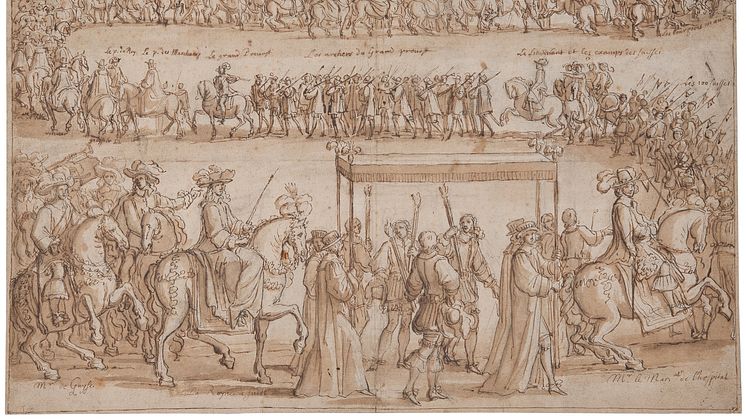
Press release -
New acquisition: A 17th century drawing by François Chavueau of Queen Kristina entering Paris in 1656
The Nationalmuseum has acquired a drawing by François Chauveau depicting the procession of Queen Kristina’s solemn entry into Paris on 8 September 1656. She was then at the height of her sovereign fame and large crowds of people had gathered on the streets of the city to get a glimpse of the Queen. Until now, the drawing has been part of a private art collection in France.
Following her abdication, Queen Kristina left Sweden in the summer of 1654. A year later, just before Christmas in 1655, she arrived in Rome without any definite plans for the future. The following summer, she set off for Paris. She was officially thought to be going to Sweden to negotiate about her financial allowance but in fact, her intentions could not have been more different. She had secretely been conferring with the leader of France, Cardinal Mazarin, about launching a military attack on southern Italy, the success of which would make Kristina the Queen of Naples. Eighteen- year-old King Ludvig XIV was initiated into the plans and subsequently, gave the order that Queen Kristina was to be received in France as a soverign ruler.
François Chauveau (1613 – 1676) were soon recognised for his graphic drawings. Many literary works were illustrated by François Chauveau whose etchings were either based on his own drawings or those of other people. In the 1660s, he was commissioned by Ludvig XIV to engrave images of the tournament organised in celebration of the birth of his son and successive heir in 1662, an assignment that earned him the title ’Royal Engraver’. Royal festivities and ceremonies were usually documented by way of graphic drawings. The drawings and pictures were arranged to vividly recount the course of events, much like the news graphics of today. The engravings gave an official picture of the (often very expensive) festivities, the purpose of which was to impress both foreign and domestic subjects. There are a number of engravings that depict Queen Kristina’s solemn entry into Paris and this drawing is most likely an outline for such an engraving. Another exquisitely detailed drawing signed by ’Chauveau’ can be found in the French National Library.
The long procession is here seen winding its way towards Notre Dame as faintly shown in the top right-hand corner. In the foreground, Queen Kristina can be seen riding sidesaddle and holding a walking stick. In front of her, four officials are each carrying a canopy. One of the canopies, embroidered with the Coat of Arms of Sweden, was handed over to the Queen at the city gate with the intention that she would ride underneath it when entering the city. However, according to the newspaper La Gazette, her horse Licorne (”Unicorn”) shied away from the canopy and hence, it had to be carried in front of the Queen.
A year later, the French tributes to Queen Kristina gave way to indignation and hatred when the Queen had her Royal Equerry by the name of Monaldesco executed at the Castle of Fontainebleau after he had betrayed and thus, foiled her plans of becoming the Queen of Naples.
The acquisition of this drawing was made possible due to a bequest from the Wiros Fund. The National Museum has no funds and means of its own to acquire artwork and therefore, its collections can only be enriched through the kind donation of private individuals as well as foundations and funds.
Inventory number
NMH 63/2017
Additional information
Martin Olin, Deputy Director of Research and Collections, martin.olin@nationalmuseum.se, tel. +46 (0)8 519 543 10
Mattias Robertson, Head of Press, press@nationalmuseum.se, +46 (0)767 23 46 32
Categories
Nationalmuseum is Sweden’s museum of art and design. The collections comprise older paintings, sculpture, drawings and graphic art, and applied art and design up to the present day. The museum building is currently under renovation and scheduled to open again October 13, 2018. In the meantime, the museum will continue its activities through collaborations both in Sweden and abroad. Nationalmuseum has partnerships with Svenska Dagbladet and the Grand Hôtel Stockholm.

